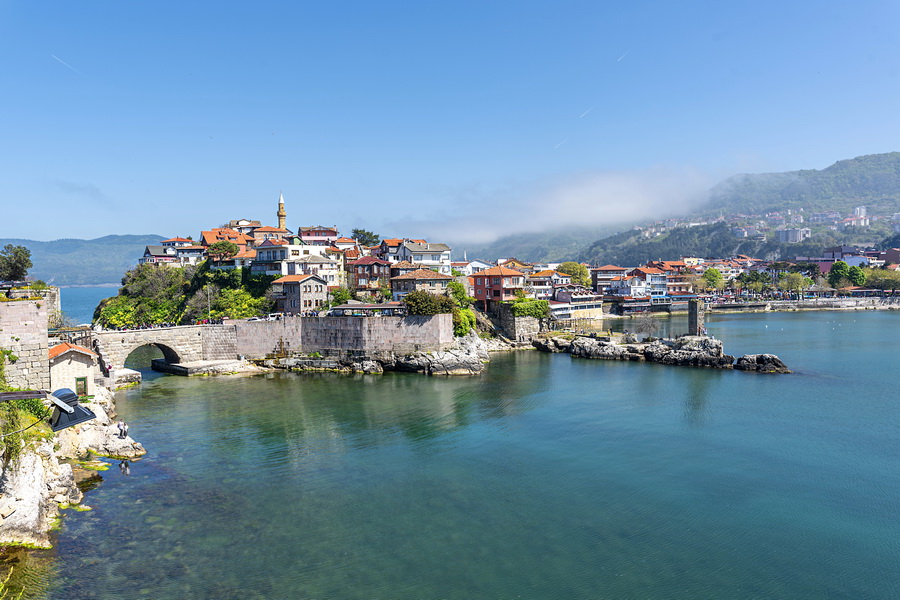In Turkey (Türkiye)'s Black Sea Region (Karadeniz Bölgesi), nature expresses itself with almost mythological force where flowing rivers penetrate emerald valleys and thunderous waterfalls cut out the sounds of metropolitan life.
Also known as Pontus, the Turkey Black Sea Region blossoms under frequent rains, making farming the lifeblood of its economy. The local culture is an eclectic combination of Anatolian warmth and Caucasian influences, reflected in its distinct dialect, traditions and mouthwatering cuisine. A breathtaking coastal road starts just east of Istanbul and winds all the way to Georgia.
This is a land of wild beauty where the pastoral rhythms of hazelnut orchards and tea plantations complement the distinct pulse of indigenous civilisations like Laz, Hemsin and Trabzon, protecting nearly extinct languages and customs. For the urban exile and Turkey Black Sea travel, it can provide an escape into harmony: dense woods alive with wildlife, mountain towns preserved in time and adrenaline-fuelled thrills like rafting and trekking next to the peaceful artistry of silk weavers and blacksmiths. From old monasteries to towns mentioned in the Iliad, far from the tourist-laden roads, it presents an unexplored mosaic of historic monuments for international tourists.
Every turn exposes another horizon; hence, a road trip here through Ordu, Rize and Kastamonu unfolds like a dialectic between Black Sea nature and civilisation. Turkey's green paradise, where the ground itself seems alive.
Turkey Black Sea Region Tours
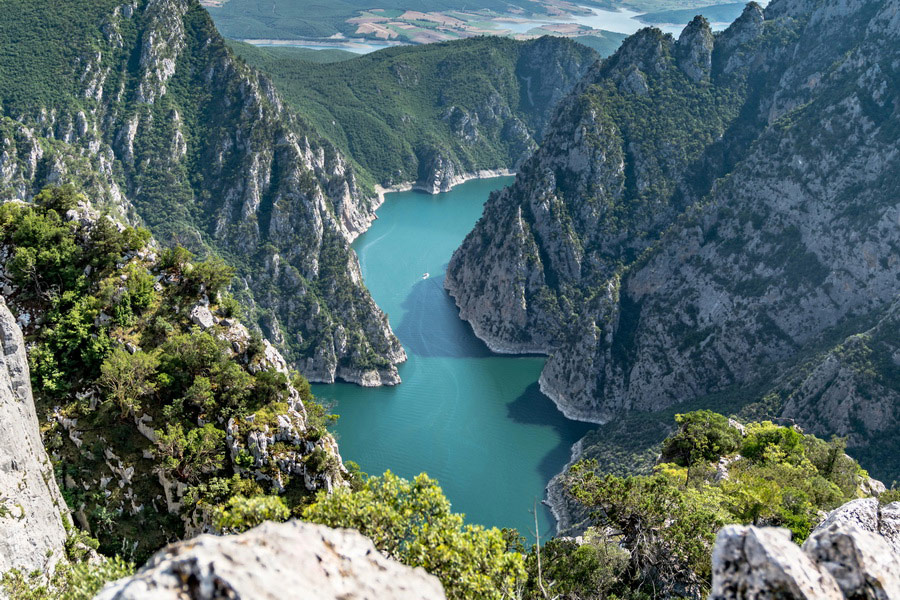
Black Sea tours in Turkey assure a wild and untamed amount of green flowing down the mountains, climbing over stone walls and encircling remote communities. Exploring the Black Sea by cruise usually connects you to Trabzon, Constanta and Batumi.
In Turkey, tours of the Black Sea Region showcase the allure of the 1000-year-old Sümela Monastery (Sümela Manastırı), the Zil Castle (Zilkale) of Rize, and the Safranbolu houses in Karabük stand as witnesses of history. Along the Black Sea coast, you can explore the biggest canyon of Turkey in Kastamonu, take a ferry at Şahinkaya Canyon (Şahinkaya kanyonu) , admire the colourful Yedigöller National Park in Bolu, and drink traditional Turkish tea in Rize, all of which givie you a dreamlike Turkey Black Sea travel experience.
People come to escape in this land shaped by water, where shepherds still move herds with whistles, adventurers raft the Çoruh's waves, old women sell golden butter made from the milk of cows that graze on alpine flowers, and in Trabzon, blacksmiths hammer out knives the same way their grandfathers did.
Road Trip along the Black Sea Coast, Turkey
Stretching from Zonguldak to Rize, Turkey's Black Sea resorts deliver a beautiful road drive among historic monuments, mountains, and rich valleys. Known for its moderate temperature and tea growing, the area stays largely unexplored by foreign visitors.
A UNESCO-listed Ottoman village, Safranbolu celebrates a traditional blacksmith market, cobblestone streets and well-preserved timber homes. Amasra, a coastal village, is one of the top-notch Black Sea resorts in Turkey, with Roman-era fortifications, ancient remains and seafood eateries. A Silk Road port, Trabzon is home to the cliffside Sumela Monastery (Sümela), dating back to 386 CE, and the 13th-century Hagia Sophia Mosque.
Drive away from the coast for a bit and boom – among the most picturesque Black Sea resorts, Turkey's Uzungöl stuns visitors with its alpine lake framed by misty mountains and traditional wooden hotels. Now, if you swing over to Rize, you’ll find lush tea terraces as far as the eye can see and wild white-water rafting in the Fırtına Valley (Fırtına Vadisi).
Best Time to Visit the Black Sea Region
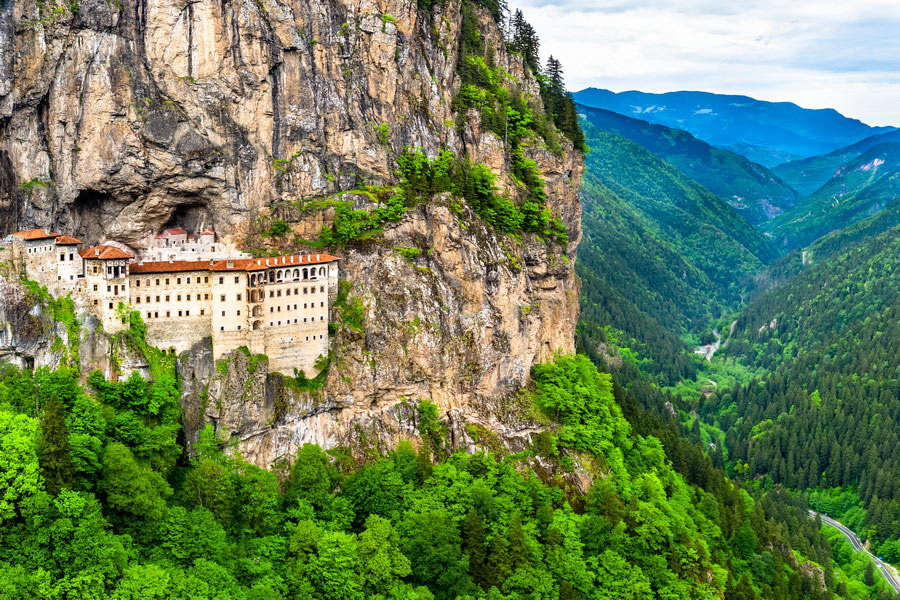
The best time to visit Turkey’s Black Sea is summer, ideal particularly along the coast near Samsun, where temperatures range from 24°C to 32°C (75.2°F to 89.6°F) . This season gets you long sunny days, making it perfect to visit for swimming and outdoor exploration. However, the Black Sea is Turkey’s dampest region, with serene frequent rainfall, majestic mist and mystic fog even in summer.
Spring and autumn provide milder temperatures and lower humidity, creating comfortable conditions for Turkey Black Sea travel for sightseeing without the peak-season crowds. October is especially scenic in Artvin, where the fall foliage transforms the landscape into a breathtaking display of colours. These seasons are also ideal for cultural visits, Black Sea hiking in Turkey and exploring historical sites like a UNESCO-listed heritage site, Trabzon’s Sümela Monastery.
Winter attracts visitors with its unique charm, particularly in Rize and Trabzon, where the climate remains mild despite occasional snow in higher altitudes. Adventure tourism in Turkey's Black Sea is so successful in winter, with the Kaçkar Mountains’s world-class heli-skiing from late winter to early spring, it draws skiers from Europe and North America.
Uncover the Charms of the 18 Provinces of the Black Sea Region of Turkey
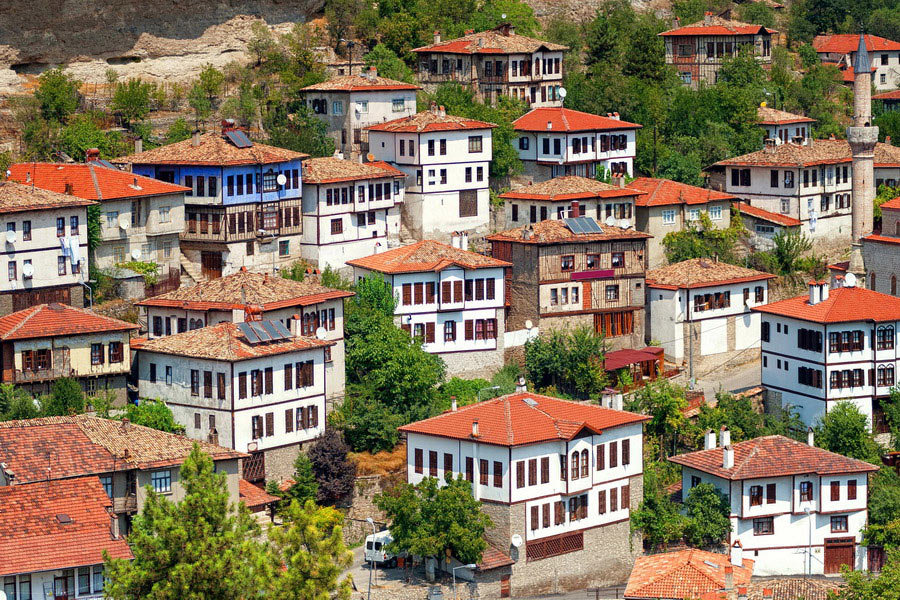
The Black Sea Region of Turkey, also known as Karadeniz Bölgesi, extends along the Black Sea to the country's northern shore. With important cities like Samsun, Trabzon, Ordu, Rize and Zonguldak, Turkey’s Black Sea Region consists of 18 provinces. The area shares borders with Central and Eastern Anatolia to the south, the Marmara Region to the west and Georgia to the northeast.
Turkey's Black Sea Region incorporates an extensive variety of Black Sea tourism Turkey opportunities, including historical monuments such as Safranbolu's Ottoman houses and ecotourism in the Kaçkar Mountains (Kaçkar Dağları). The region's economy is based on agriculture, fishing and mining, with ports such as Zonguldak facilitating trade.
Notable provinces fully inside the region include Amasya, recognised for its historical significance as Strabo's birthplace; Giresun, celebrated for its hazelnut production; and Trabzon, home to the ancient religious wonder – Sümela Monastery. Rize, with its blooming tea plantations, and Sinop, the site of well-preserved coastal fortifications, are also unique. Some provinces, such as Artvin and Bayburt, lie mostly within the region, while others like Çorum are partially included. Tokat is home to one of the largest caves in Turkey, the magnificent Ballıca Cave, and historic landmarks like the 15th-century Hatuniye Külliyesi and a Seljuk bridge crossing the Yeşilırmak River, while Düzce features the ancient city of Prusias ad Hypium, the serene Samandere Waterfall, and the picturesque coastal town of Akçakoca along the Black Sea coast.
Explore the History of Turkey’s Black Sea Region

The history of Turkey’s Black Sea region starts with the Greeks, who first mentioned it as Pontos, which means “sea”, derived from the Greek name of the Black Sea. The coastal area and the mountainous interior, especially the Pontic Alps, were first inhabited by various indigenous peoples, including the Kaška, who lived beyond the control of the Bronze Age empires like the Hittites. From around 1000 BC Greek merchants started to arrive, and by the 8th century BC permanent colonies like Sinope were established. The region was closely related to Greek mythology and was later absorbed into the Achaemenid Empire in the 6th century BC.
The Kingdom of Pontus was founded by a Persian dynasty in the 4th century BC and became a major Hellenistic state under Mithridates VI, who mixed Persian with Greek culture. After the Roman conquest in 64 BC, the region was divided into the provinces of Bithynia et Pontus and Galatia with minimal impact on local governance.
During the Byzantine period, Pontus was reorganised by Emperor Justinian and remained culturally important, especially Trebizond (currently Trabzon), which later became the capital of the Empire of Trebizond after the fall of Constantinople in 1204. This independent state survived until it fell to the Ottomans in 1461.
Under Ottoman rule Pontus was part of the Trebizond Vilayet and had a significant Christian Greek minority. Some communities converted to Islam over time, but many retained their Greek dialect and traditions. After World War I a short-lived proposal for a Republic of Pontus was discussed but never materialised. The subsequent population exchange between Greece and Turkey resulted in significant demographic changes in the region, leading to a reduction in the number of Greek residents within the local Pontic Greek communities.
Plan your Dream Holidays in the Black Region of Turkey
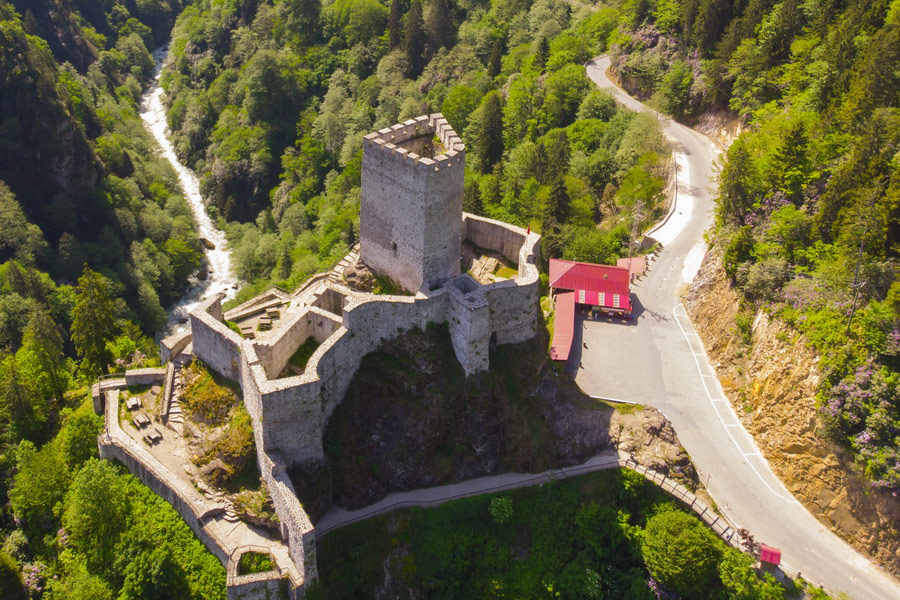
Surrounded by wild mountains and wilder sea, Turkey’s Black Sea Region is a place of raw beauty, old traditions and warm welcomes, guaranteeing the perfect Black Sea holidays in Turkey. From the fairy tale lake of Uzungöl to the cliffside Sümela Monastery, this is a region for curious travellers, granting you incomparable Black Sea travel in Turkey.
Nature & Adventure
The Kaçkar Mountains are a trekking paradise and one of the best Black Sea resorts in Turkey, with alpine meadows, glacial lakes and highland villages that seem to be lost in time. Raft the Fırtına River, ski the slopes of Zigana in winter or soak in Ayder’s thermal springs, which continue the 600-year tradition of therapeutic bathing perfected in Turkish hammams. And don’t miss paragliding over Uzungöl – it’s a must.
Culture That Runs Deep
History and culture are in bloom here. Visit the Zilkale fortress, stroll through Atatürk’s mansions in Trabzon and Rize, and watch the horon traditional folk dances at a summer Kadirga Festival in Yayla Plateau. Dock your yacht near Giresun Island (Giresun Adası), which has stories of Amazons – female warriors and hunters who lived along the Anatolia and were renowned for their physical agility, strength, archery, riding abilities and battle techniques.
By the Sea, or in the Hills
Coastal towns like Amasra and Sinop combine history with Black Sea beaches in Turkey. Inland, places like Şavşat and Boztepe in Ordu convey quiet escapes and big views. Küre Mountains National Park stretches across Kastamonu and Bartın provinces and is a haven of deep canyons, lush forests, and rich biodiversity.
Marvel at Nature's Wonders and Delight in Outdoor Activities

The Black Sea region of Turkey is full of stunning landscapes, with forests, mountains and ultramarine waters. It’s a paradise for nature lovers with Black Sea hiking, rafting, birdwatching and camping opportunities.
Yedigöller National Park (Yedigöller Millî Parkı) in Bolu has 7 lakes surrounded by dense forests that turn orange and red in autumn. The park has well-maintained walking paths perfect for Black Sea nature Turkey walks and photography, refining Black Sea tourism.
Kaçkar Mountains National Park (Kaçkar Dağları Millî Parkı) in Rize has rugged peaks, glacial lakes and deep valleys. The highest point, Kaçkar Zirvesi, is 3937m and has trails for all levels. It’s also a hot spot for wildlife observation in Turkey with mountain goats and rare bird species.
Uzungöl in Trabzon represents a peaceful lake encircled by hills and spruce forests. You can walk around the lake or take highland tours to nearby areas like Şekersu and Demirkapı.
For thrill seekers Şahinkaya Canyon in Samsun suggests paragliding, scuba diving and camping possibilities. The canyon’s steep cliffs and flowing river are a dramatic setting for outdoor sports.
Fırtına Valley in Rize is the heart of rafting with its fast-flowing rivers and scenic stone bridges. The valley also has historical landmarks like Zilkale, where nature and culture come together.
Borçka Karagöl in Artvin is a peaceful mountain lake encompassed by forests, perfect for birdwatching and short hikes. The area is known for its untouched wilderness and endemic plant species.
Fishing in the Black Sea Turkey is a traditional activity; locals and visitors catch anchovy, bonito and trout. Coastal towns will make you happy with fishing excursions, and inland rivers bring freshwater fishing.
Black Sea hiking trails, including the Kaçkar Trail, lie across high-altitude plateaus, glacial lakes and forests. The Black Sea coastline also has secluded Black Sea beaches and cliffs which are ideal for kayaking and coastal walks. For eco-tourism, Ulugöl Natural Park (Ulugöl Tabiat Parkı) in Ordu and Sümela Monastery’s forested slopes are a nature immersion experience. Wildlife tours and botanical excursions are popular in areas like Giresun’s Gölyanı Highland and Artvin’s Karagöl mountain, enhancing Black Sea Holidays Turkey.
With its nature parks, adventure tourism in Turkey's Black Sea and camping sites, the Black Sea region is the perfect destination for outdoor activities in Turkey. Hiking, rafting or birdwatching, you’ll find the most beautiful Black Sea nature in Turkey and diverse ecosystems.
Green Escapes: Ecoregions and Sustainable Destinations

Ecoregions
The Euxine-Colchic broadleaf forests (Euxine-Kolşik yaprak döken ormanlar) extend along the southern Black Sea coast from Bulgaria to Georgia with temperate rainforests and high rainfall (1,500–4,000 mm per year). Main trees are Oriental beech, chestnut and fir with an understory of evergreen shrubs like Pontic rhododendron. The drier Euxinic forests are west of Ordu with 1,000–1,500 mm of rain.
Northern Anatolian conifer and deciduous forests (Kuzey Anadolu kozalaklı ve yaprak döken ormanları) cover the Pontic Mountains and are between coastal and continental climates. Conifers like Turkish fir and Scots pine dominate, with deciduous species like oak and maple. Brown bears, wolves and deer are found here. Kaçkar National Park protects these habitats. The region has many different ecosystems and high biodiversity due to elevation and precipitation, completing the Black Sea holidays in Turkey.
Cittaslow
There are numerous Cittaslow cities in the Black Sea region of Turkey, each of which has its own distinct natural and cultural history. Known for its heritage from the Hittite era, wooden crafts and Sorkun Waterfalls, Gerze (Sinop) has been a member since 2017. Historically a centre of the saffron trade, Göynük (Bolu) still has Ottoman architecture and is embraced by undeveloped lakes like Sünnet and Çubuk. In addition to having more than 180 historic homes, Mudurnu (Bolu), which was designated a Cittaslow in 2018, is close to Lake Abant, a home to rare species like the Abant trout.
Perşembe (Ordu) has outstanding coastal geography, including Cape Yason and Hoynat Islet, an important bird habitat. Şavşat (Artvin), Turkey's 10th Cittaslow, is positioned near the Kaçkar Mountains and Karagöl-Sahara National Park. Safranbolu (Karabük), a UNESCO World Heritage Site, is well-known for Ottoman-era architecture and saffron production. Daday (Kastamonu) maintains its Ottoman horsemanship tradition through the supply of horse safaris and beautiful wooden homes. These towns value preservation, Black Sea nature in Turkey and idle living.
Major Islands
The Turkish Black Sea coast holds several significant islands on its body. Amasra Tavşan Adası, near Bartın, carries ancient ruins and wildlife. Giresun Island, the only inhabited island of the eastern Black Sea, embraces ruins of a temple of Artemis. Off Ordu is Hoynat Islet, a site for bird watching. On Kefken Island, near Kocaeli, the Turkish Black Sea beaches and ancient ruins stand together. Öreke Island, near Istanbul, provides a private escape with rocky landscapes – a super Black Sea tourism destination in Turkey.
Reconnect with Nature by Experiencing Farm Stays and Agrotourism
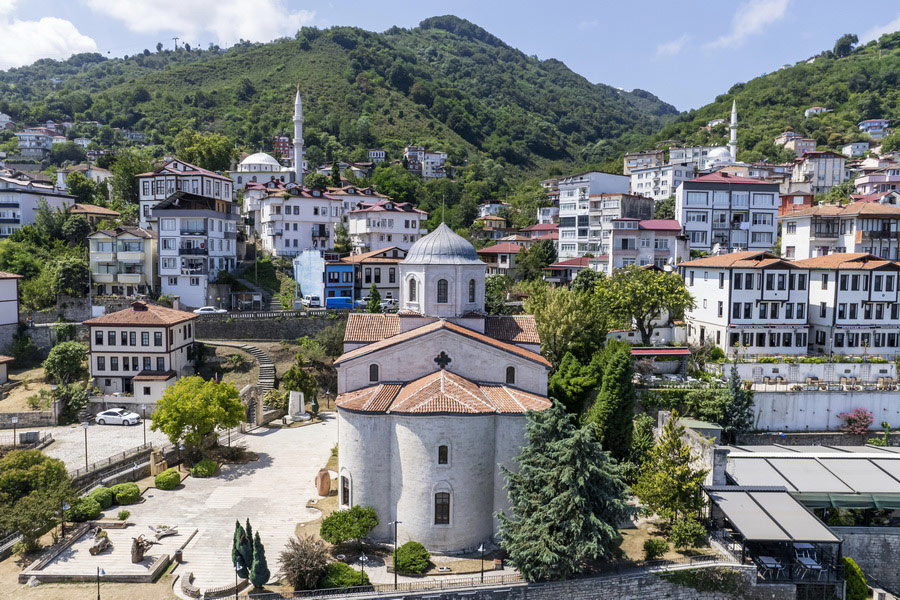
The Black Sea Region of Turkey is great for rural tourism, featuring Black Sea resorts, agrotourism findings and farm stays. Its highlands, thermal hotels and local practices draw more and more tourists, both from Turkey and abroad. Trabzon is the standout city here, packed with tourist spots and backed by good infrastructure like an international airport and universities. Other places like Ordu, Giresun and Rize are also ramping up their tourism with new airports in the works.
Rural tourism genuinely helps the local economy by creating jobs, keeping people from moving away and boosting living standards. But there's a challenge with unplanned construction impacting farmland and the landscape, highlighting the need for thoughtful planning that balances economic growth with social and environmental considerations. The Black Sea Sustainable Rural Tourism Program, which took four years to develop, aims to address these issues by encouraging community-based tourism that meets global sustainability standards. Local groups are working with businesses and places to stay, while an international platform helps with bookings and cultural events. Additionally, exchanges between Turkey, Ukraine and Georgia are helping promote sustainable practices.
One of the outstanding sustainable tourism centres in Turkey’s Black Sea Region is Narköy, an organic farm. It functions as both a modern farm and hotel, providing 14 rooms, accommodations for families and groups, and a restaurant that serves meals prepared with organic farm produce. The facility includes indoor and outdoor classrooms and is situated within a forested area.
With its stunning Black Sea nature and Turkey's tremendous culture, the Black Sea Region has the potential to become a top destination for agritourism.
Embrace Sustainable Shopping: Enjoy Eco-Friendly Finds
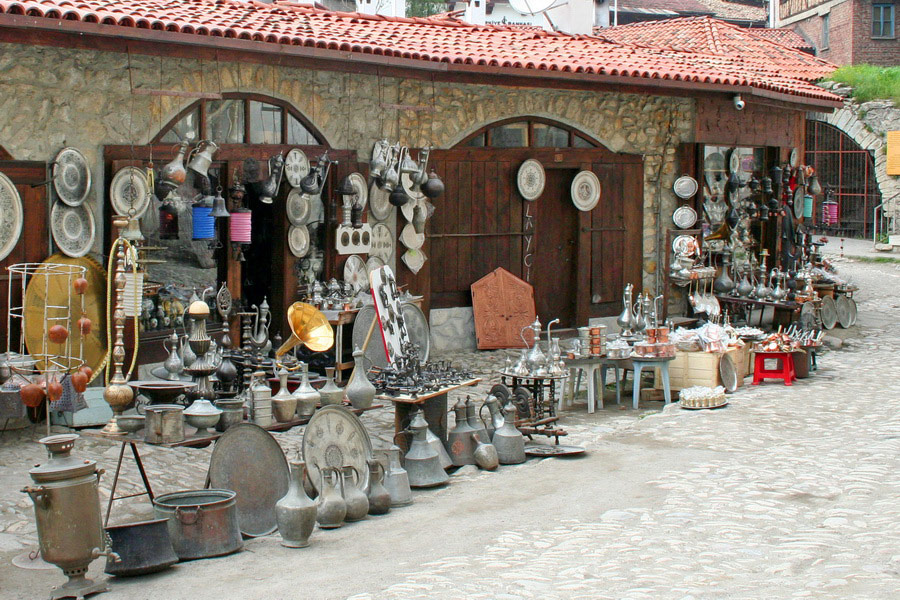
The Black Sea region of Turkey is a goldmine of diverse markets and bazaars emphasising sustainability, local craftsmanship and organic products where vendors quote prices in Turkish lira. In Trabzon, the historic Bedesten Bazaar sells high-quality textiles, leather goods, and wool products, preserving Ottoman-era trade traditions. Rize is renowned for its tea, durable Rize cloth, Turkish boxwood spoons and Anzer honey, a premium regional product, enhancing the Black Sea holidays in Turkey.
Ordu’s Kabakdağı Eco Tourism Centre & Organic Market pays tribute to organic produce, dairy, jams and handicrafts, sourced directly from local farmers. Open every Sunday, it ensures authentic, chemical-free goods. Nearby, Ünye’s Coppersmith Bazaar showcases traditional metalwork, with restored historical shops selling handmade copper items.
In Safranbolu, the Metalworker's Bazaar spotlights artisanal metal trays and farm tools, while the Safranbolu Bazaar presents saffron-based products like jam, Turkish delight (lokum) and Turkish perfume cologne (kolonya), alongside fresh local herbs and non-industrial crafts. Bolu’s Monday market is a centre of organic commodities, dairy and handmade goods, attracting shoppers seeking fresh and affordable items.
Samsun’s Yabancılar Bazaar and nearby streets feature traditional rugs with historic weaving techniques, while Amasya’s Bedesten Bazaar is ideal for spices, handmade wares and seasonal treats like apples and honey. The Pervane Madrasah in Amasya doubles as a marketplace for local tradesmen.
Sinop specialises in ship maquettes, Ayancık linen, and Diogenes-themed souvenirs, available in traditional bazaars.
A Taste of Tradition: Savour Karadeniz Bölgesi Traditional Food
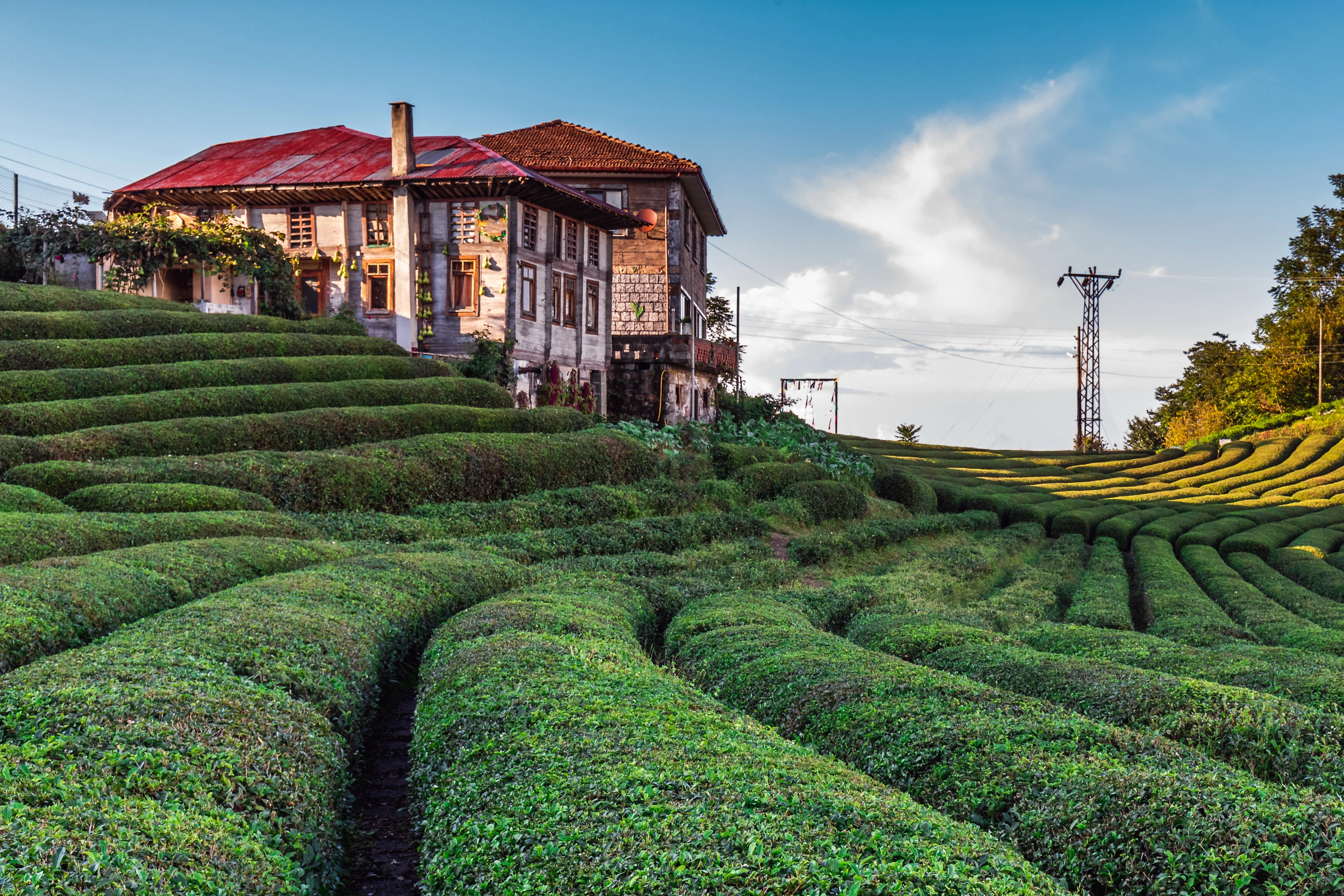
The Black Sea region in Turkey has a unique food scene because of ingredients like corn, kale, anchovies and dairy. A popular dish there is kuymak, a filling breakfast made with cornmeal and melted cheese, often with some butter or kaymak (clotted cream) mixed in. Another favourite is Bafra pidesi, a long savoury pie stuffed with spiced ground beef and baked in a wood oven.
Meat is a big deal in this area's cooking. Tokat kebabı features lamb and roasted veggies, while Akçaabat köftesi is full of veal meatballs with garlic and onion. Fish in the Black Sea, Turkey, is also important, especially hamsi tava (fried anchovies) and hamsili pilav, a rice dish wrapped in anchovies.
Corn dishes are also widespread in Turkey's Black Sea Region, like mısır ekmeği (cornbread) that sometimes has cheese or sardines in it and nokul, a pastry that can be sweet or savoury and is filled with poppy seeds or walnuts. You’ll find hearty soups like karalahana çorbası (kale soup) and stews like orman kebabı (lamb or beef with veggies) that show off local ingredients.
Towns like Rize, Giresun and Trabzon each have their own specialities: Rize is known for ekşi aşi (sour bean soup), Giresun has hamsi böreği (anchovy pastry) and Trabzon boasts Akçaabat köftesi. The cuisine here merges fresh seafood, wild greens, dairy and corn, positioning the region as rich and diverse in food practices.
Explore Local Tea in the Turkey Black Sea Region
Turkey ranks as the fifth-largest tea producer in the world, and its people drink more tea per person than anyone else. Most of the tea in Turkey comes from Rize, a city in the Black Sea area, where the climate is ideal for growing. The tea industry started back in the 1930s with seeds brought in from Georgia, and since then, Rize has become the heart of Turkey's tea production. Today, around 200,000 families earn their living from growing tea, which makes up about 4.6% of global tea supply.
Turkish tea is made using a special double teapot called a çaydanlık. First, a strong tea concentrate is made, which is then mixed with hot water according to how you like it. It's usually served in tulip-shaped glasses, often sweetened with sugar, but never with milk. Tea is a big part of everyday life in Turkey, whether people are meeting friends or talking business. In Rize, you can visit tea farms and factories to see how tea is made from leaf to cup. The local economy hugely benefits from tea, with popular brands like Çaykur leading the way, even with Black Sea holidays in Turkey. For a true taste of Turkey, enjoy a freshly brewed çay in a tea garden where you can chat and soak in the vivacious tea culture.
Enjoy the colourful local festivals of the Turkish Black Sea Region
Hosting numerous festivals in August, which celebrate local traditions, food and nature, the Turkey Black Sea Region represents an outstanding local festival destination. The Ayder Highlands in Rize, famous for its honey, holds a festival on the first weekend of August honouring traditional dances, food preparation and honey-themed activities. During the festival, visitors can additionally explore Ayder’s waterfalls, thermal resorts, and trekking routes.
Uzungöl in Trabzon, illustrious for its picturesque lake and serene landscape, holds its main festival in early August, with smaller events continuing into September. Activities include trekking, paragliding and traditional food tastings. The area is plunged in boutique wooden hotels with views of the lake and mountains.
In Artvin, the Yusufeli Highlands attract nature lovers with 17 trekking routes and the Mount Pancar Festival on August 9, promoting sports, traditional dances and local hospitality. Artvin is also known for its rich biodiversity, including 45 butterfly species.
Other notable festivals include the Anzer Honey Festival in Rize (first weekend of August), the Çamoluk Honey Festival in Giresun (August 21) and the Kadırga Festival in Gümüşhane (first week of August), one of the region’s largest. The Tonya Butter Festival (August 28-29) highlights local dairy products, while the Sultan Murat Festival in Trabzon (August 20) showcases energetic horon dances.
Note: The dates of the festivals usually change annually, so checking them before making any decisions is highly recommended.
How to Reach the Untamed Black Sea Region of Turkey
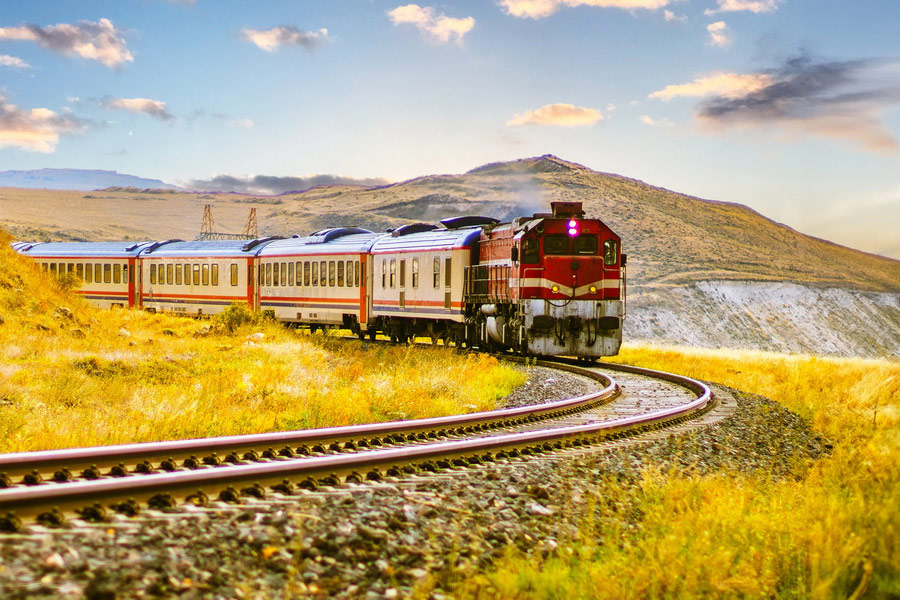
Checking out Turkey’s Black Sea Region is a real treat, with its beautiful scenery and marvellous culture. No matter how you like to travel, you’ve got plenty of options.
The quickest way to get to the Black Sea Region of Turkey is by flying. Airports in Trabzon, Samsun and Rize have tonnes of flights from places like Ankara and Istanbul. Both budget and traditional airlines fly daily, making it easy to kick off your trip.
Once you arrive in Turkey’s Black Sea Region, you can hop on a local bus, grab a taxi or rent a car to reach the lovely coastal towns, misty mountains and famous tea plantations.
If you want a more laid-back option to get to the Black Sea, Turkey, consider taking a bus from Istanbul, Ankara or even Batumi, Georgia. These comfortable coaches have reclining seats, making the 12- to 14-hour ride pretty enjoyable, with ticket prices around $20 to $50 (€17.80 to €44.50 and £15 to £37.50).
For those who enjoy road trips, renting a car gives you the chance to find hidden spots along the scenic coastal roads, from the striking cliffs of Amasra to the peaceful beauty of Uzungöl.
While not as common as in other regions, there are ferry routes from Istanbul to some Black Sea ports, guaranteeing a nice sea journey. There’s also the Eastern Express train, which rides from Ankara to Kars and takes you through breathtaking landscapes, with stops near the eastern part of the Black Sea.


